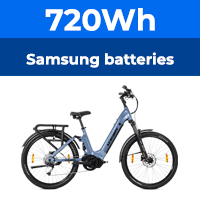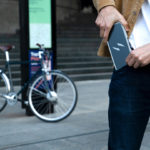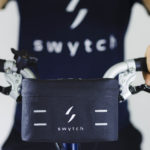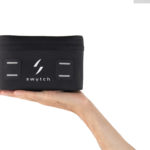It seems to be an accepted norm that one can never have too many bicycles (n+1). That said, I haven’t seen a similar argument presented when it comes to tandems!
We have an Orbit Velocity tandem which was converted to e-assist several years ago with the installation of a Woosh 48 Volt DWG22C rear hub motor. It has been a super upgrade, the motor has been very reliable and it has covered around 6K fault free miles now.
We recently had an opportunity to obtain an old(ish) Thorn Explorer tandem which had been converted with the addition of a Tongshen TSDZ2 mid-drive motor (36 Volt). The big selling point however, was that it also had a Rohloff Speedhub fitted. Most will be aware of this (expensive) German 14 speed hub which is generally highly regarded, especially for tandems.
The Rohloff hub has a chainline of 58mm and paradoxically, the offset of the 42 tooth chainring of the Tongshen is actually too far inset - just the opposite of what you'd expect with a more normal derailleur setup. By removing the chainguard and fitting the chainring on the outer side of the mounting spider, I could get the chainline pretty much dead on. I accept that we're pushing our luck a bit using the smaller Tongshen motor on a tandem - it's asking a lot of it, but we use the motor to help us up hills and into headwinds, not as an electric motorcycle.
Rather than have conventional LHS tandem cross-over cranks for the timing chain, the Thorn conversion as we purchased it, used ordinary cranks on the RHS to run the timing chain. Whilst this worked, it did create quite a wide ‘Q’ factor. To keep battery commonality with our other bikes, I decided to change out the 36 Volt TSDZ2 for a new 48 Volt TSDZ2B from Woosh.

I had measured clearances quite carefully and there would be enough room (just!) between the LHS crank arm and motor casing to use normal tandem cross-over rear cranks with a bit of judicious machining and countersinking of the chainring bolts. The obvious motor to use on a tandem would really be the newer and more powerful TSDZ8, but that is just slightly too wide to give clearance for the LHS tandem crank. In addition, the boom tube on a tandem prevents the motor from tilting up to its normal position against the down tube, so a larger motor would be forced to sit quite close to the ground. The lower riding Thorn bottom bracket is already 40mm closer to the ground than the Orbit. The cost of the TSDZ2B was low enough to justify ‘taking a punt’ to see if we could make it work. The new motor arrived and it quickly became apparent that the specs for axle width had changed from the original 36 Volt TSDZ2 as the LHS crank arm now fouled the motor casing. Goodness I thought, that’s a tad inconvenient. Hey-ho, plan B was invoked to set the conversion up in the same way as the original motor with the timing chain on the RHS.
LHS crank arm fouling with first 48 Volt motor:

Everything was installed and a test run on the workstand using the throttle was successful. The first road test was a lot less satisfactory. The new motor did not react at all when ridden solo from the front (the original 36 Volt one had). Plus, when the stoker was aboard the power fluctuated quite noticeably and regularly. It was bit like having a gentle low frequency sine-wave oscillation of the power delivery. Using the throttle was smooth though. Following a few tests / checks suggested via emails with customer support at Woosh, a replacement unit was immediately shipped for next day delivery. I didn’t have the hassle of returning the first unit and waiting for an examination, just an acknowledgement that something was clearly not right and a replacement was appropriate in this case. Credit to Woosh – they have a reputation for good customer service and my experience would certainly back this up.
The new motor was installed – but- guess what, the axle now allowed for the timing chain to be mounted on the LHS as my initial measurements had indicated. Perhaps the axle on the first motor was not installed correctly at the factory? Who knows. A short test ride confirmed that there must have been a fault with the first unit as it was now possible to ride solo from the front and engage the motor. Power was also smooth, as expected. The stoker also noted that this motor seemed much smoother.
LHS crank arm clearance with the replacement 48 Volt motor following some 'farmboy' machining:

From my limited test rides, subjectively I think our our 60Nm DWG22C hub motors feel like they have a fair bit more 'grunt' than the Tongshen and (touch wood) have been completely reliable. I'm hoping the low gearing on the Rohloff and mid-drive will get us up some of the steeper hills we have locally. I tend to avoid some of those hills so we don't cook the DWG22C by running it too slowly. We’re spinners rather than stampers and keep a relatively high cadence but I will probably add some heat sinks to the TSDZ2B motor in due course. Additional bearings on both sides of the axle seem like a good idea too as rear bottom brackets on a tandem get quite a hard time. I liked nealh’s suggestion (in another thread) of using neoprene washers with the bearings to act as dust / water seals on the bearings – good thinking.
We bought the 26” wheel Thorn with the intention of using it more on gravel tracks / paths as it can take quite wide MTB type tyres if required. Pace is definitely more sedate than our 700C wheel Orbit Velocity which feels quite fast and ‘sporty’ in comparison. The two bikes look similar, but have quite different characterisics. The Thorn is a more relaxed (plodding?) proposition. Both are great fun though.


We have an Orbit Velocity tandem which was converted to e-assist several years ago with the installation of a Woosh 48 Volt DWG22C rear hub motor. It has been a super upgrade, the motor has been very reliable and it has covered around 6K fault free miles now.
We recently had an opportunity to obtain an old(ish) Thorn Explorer tandem which had been converted with the addition of a Tongshen TSDZ2 mid-drive motor (36 Volt). The big selling point however, was that it also had a Rohloff Speedhub fitted. Most will be aware of this (expensive) German 14 speed hub which is generally highly regarded, especially for tandems.
The Rohloff hub has a chainline of 58mm and paradoxically, the offset of the 42 tooth chainring of the Tongshen is actually too far inset - just the opposite of what you'd expect with a more normal derailleur setup. By removing the chainguard and fitting the chainring on the outer side of the mounting spider, I could get the chainline pretty much dead on. I accept that we're pushing our luck a bit using the smaller Tongshen motor on a tandem - it's asking a lot of it, but we use the motor to help us up hills and into headwinds, not as an electric motorcycle.
Rather than have conventional LHS tandem cross-over cranks for the timing chain, the Thorn conversion as we purchased it, used ordinary cranks on the RHS to run the timing chain. Whilst this worked, it did create quite a wide ‘Q’ factor. To keep battery commonality with our other bikes, I decided to change out the 36 Volt TSDZ2 for a new 48 Volt TSDZ2B from Woosh.

I had measured clearances quite carefully and there would be enough room (just!) between the LHS crank arm and motor casing to use normal tandem cross-over rear cranks with a bit of judicious machining and countersinking of the chainring bolts. The obvious motor to use on a tandem would really be the newer and more powerful TSDZ8, but that is just slightly too wide to give clearance for the LHS tandem crank. In addition, the boom tube on a tandem prevents the motor from tilting up to its normal position against the down tube, so a larger motor would be forced to sit quite close to the ground. The lower riding Thorn bottom bracket is already 40mm closer to the ground than the Orbit. The cost of the TSDZ2B was low enough to justify ‘taking a punt’ to see if we could make it work. The new motor arrived and it quickly became apparent that the specs for axle width had changed from the original 36 Volt TSDZ2 as the LHS crank arm now fouled the motor casing. Goodness I thought, that’s a tad inconvenient. Hey-ho, plan B was invoked to set the conversion up in the same way as the original motor with the timing chain on the RHS.
LHS crank arm fouling with first 48 Volt motor:

Everything was installed and a test run on the workstand using the throttle was successful. The first road test was a lot less satisfactory. The new motor did not react at all when ridden solo from the front (the original 36 Volt one had). Plus, when the stoker was aboard the power fluctuated quite noticeably and regularly. It was bit like having a gentle low frequency sine-wave oscillation of the power delivery. Using the throttle was smooth though. Following a few tests / checks suggested via emails with customer support at Woosh, a replacement unit was immediately shipped for next day delivery. I didn’t have the hassle of returning the first unit and waiting for an examination, just an acknowledgement that something was clearly not right and a replacement was appropriate in this case. Credit to Woosh – they have a reputation for good customer service and my experience would certainly back this up.
The new motor was installed – but- guess what, the axle now allowed for the timing chain to be mounted on the LHS as my initial measurements had indicated. Perhaps the axle on the first motor was not installed correctly at the factory? Who knows. A short test ride confirmed that there must have been a fault with the first unit as it was now possible to ride solo from the front and engage the motor. Power was also smooth, as expected. The stoker also noted that this motor seemed much smoother.
LHS crank arm clearance with the replacement 48 Volt motor following some 'farmboy' machining:

From my limited test rides, subjectively I think our our 60Nm DWG22C hub motors feel like they have a fair bit more 'grunt' than the Tongshen and (touch wood) have been completely reliable. I'm hoping the low gearing on the Rohloff and mid-drive will get us up some of the steeper hills we have locally. I tend to avoid some of those hills so we don't cook the DWG22C by running it too slowly. We’re spinners rather than stampers and keep a relatively high cadence but I will probably add some heat sinks to the TSDZ2B motor in due course. Additional bearings on both sides of the axle seem like a good idea too as rear bottom brackets on a tandem get quite a hard time. I liked nealh’s suggestion (in another thread) of using neoprene washers with the bearings to act as dust / water seals on the bearings – good thinking.
We bought the 26” wheel Thorn with the intention of using it more on gravel tracks / paths as it can take quite wide MTB type tyres if required. Pace is definitely more sedate than our 700C wheel Orbit Velocity which feels quite fast and ‘sporty’ in comparison. The two bikes look similar, but have quite different characterisics. The Thorn is a more relaxed (plodding?) proposition. Both are great fun though.







